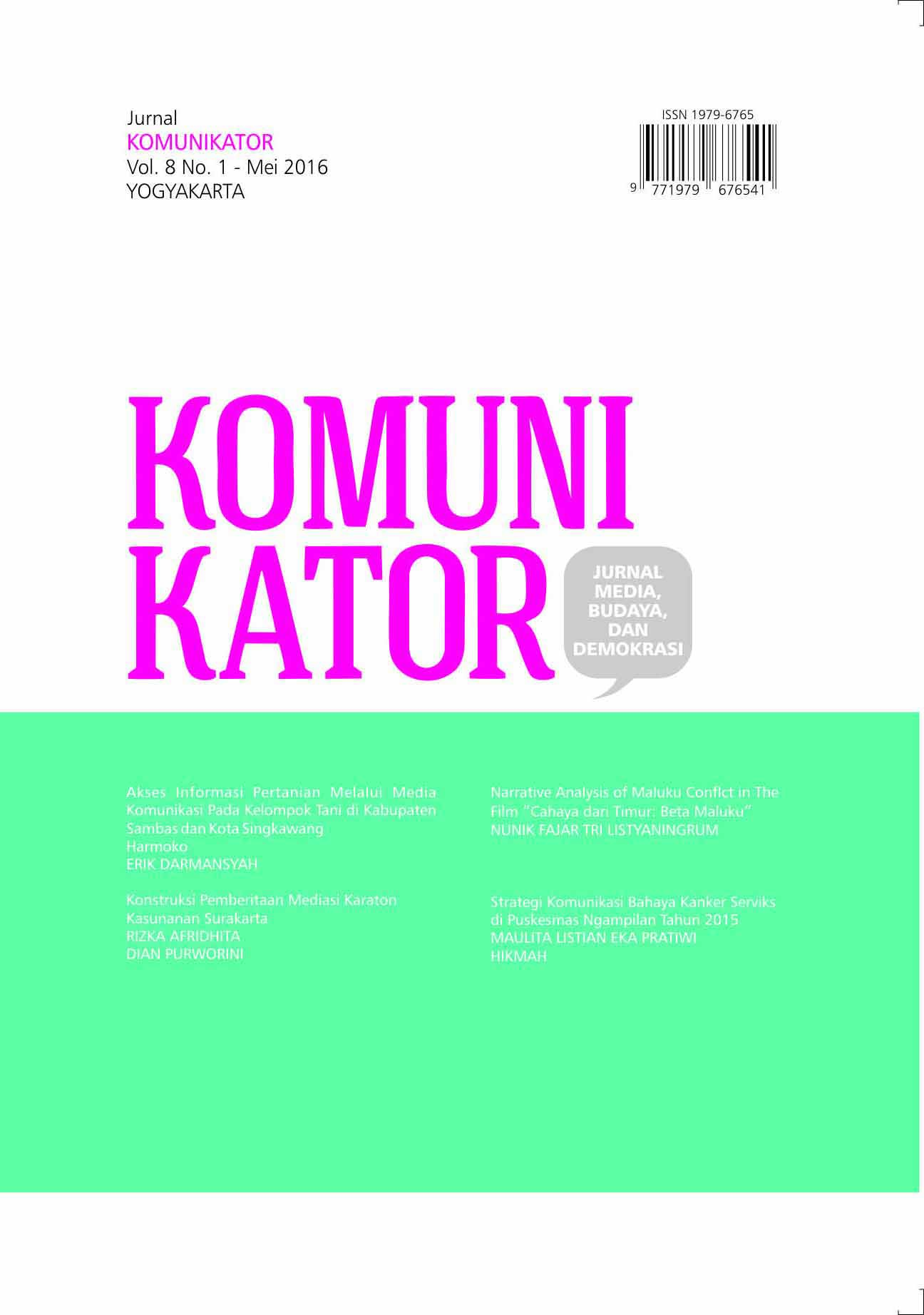Narrative Analysis of Maluku Conflict in The Film “Cahaya dari Timur: Beta Maluku”
Abstract
UN (United Nation) notes that 75% of major conflicts in the world are caused by cultural diversity. As multicultural country, Indonesia has high potential for cultural conflict. One of the biggest conflicts that ever occurred in Indonesia is Maluku conflict. This conflict had been retold in the film “Cahaya dari Timur: Beta Maluku”. The research question is “How is the Maluku conflict narrated in the film Cahaya dari Timur: beta Maluku?”. To answer the question, the researcher chooses the narrative analysis from Tzvetan Todorov. He argues that narrative is not flat. It consists of certain levels (equilibrium, disruption, recognizing the disruption, an attempt to the damage, and equilibrium). By dividing film narrative into five levels, this research finds the different condition in equilibrium level. Oftentimes, equilibrium is started by balance condition, but this film is started by conflict. Besides that, Maluku conflict is positioned as the background story.
References
Baran, S. J. (2012). Introduction to Mass Communication Media Literacy and Culture (Edisi Baha). Jakarta: Erlangga.
Bazeley, P. (2013). Qualitative Data Abalysis Practical Strategies. London: Sage Publication.
Buchanan, C. (2011). Pengelolaan Konflik di Indonesia-Sebuah Analisis Konflik di Maluku, Papua dan Poso. Retrieved from http://www.hdcentre.org/uploads/tx_news/64BahasaIndonesiaversion.pdf
Cahaya dari Timur: Beta Maluku Promosikan Ambon. (2014). Retrieved from ”. Kompas News Onlihttp://travel.kompas.com/read/2014/07/01/1148496/.Cahaya.dari.Timur.Beta.Malu
Eko, N., & Susanto, H. (2015). International Journal of Asian Social Science Discourse Analysis Construction of Reality of The Balibo Five Case in The Balibo Movie, 5(10), 551–560. http://doi.org/10.18488/journal.1/2015.5.10/1.10.551.560
Elvinaro. (2009). Komunikasi Massa: Suatu Pengantar (Edisi revi). Bandung: Refika Offset.
Eriyanto. (2015). Analisis Naratif: Dasar-Dasar dan Penerapannya dalam Analisis Teks Berita Media (Edisi ke 2). Jakarta: Prenadamedia Group.
Fachruddin, A. (2015). Cara Kreatif Memproduksi Program Televisi. Yogyakarta: Andi Offset.
Halili, bonar tigore. (2014). Stagnasi Kebebasan Beragama. Retrieved from http://setara-institute.org/book-review/stagnasi-kebebesan-beragama-laporan-kbb-2013/
Hesling, W. (2001). of Cultural Studies The past as story : The narrative structure of historical films. http://doi.org/10.1177/136754940100400201
Konflik yang Dipicu oleh Keberagaman Budaya Indonesia. (2015). Retrieved from http://nasional.tempo.co/read/news/2015/05/21/078668047/konflik-yang-dipicu-keberagaman-budaya-indonesia
Krisandi, Ernita, Budi Setyono, T. C. U. (2013). Resolusi Konflik Komunal Di Maluku Pasca Reformasi. Ilmu Pemerintahan. Retrieved from http://ejournal-s1.undip.ac.id/index.php/jpgs/article/view/2154
Kumpulan Artikel Mengenai Peristiwa Ambon. (2000). Retrieved from http://media.isnet.org/ambon/Republika05.html
Mayaut, P. (2014). Cahaya dari Timur, Demi Promosikan Ambon.
McQuail, D. (2011). Teori Komunikasi Massa (Edisi Ke-6). Jakarta: Salemba Humanika.
Neuman. (2006). Social Research Method. United States of America: Pearson International.
Qadri, M. (2016). Films and Religion : An analysis of Aamir Khan ’ s PK, 20(1).
Rivera-betancur, J. L., Ruiz-moreno, S., Pages, M., Rivera-betancur, J. L., Ruiz-moreno, S., & Pages, M. (2010). Representations of the armed conflict in Colombian cinema. http://doi.org/10.4185/RLCS-65-2010-915-503-515-EN
Smets, K. (2015). Cinemas of Conflict : A Framework of Cinematic Engagement With Violent Conflict , Illustrated With Kurdish Cinema, 9, 2434–2455.
Sukkendar. (2011). Pendidikan Damai (Peace Education) Bagi Anak-Anak Korban Konflik, 19. Retrieved from file:///C:/Users/Radik/Downloads/Documents/Sukendar-Pendidikan_Anak_Korban_Konflik.pdf
Thoyibi, M. (2015). Seminar Nasional Media dan Kuasa: Representasi Timpang Kaum Yahudi dan Muslim Dalam Film Schindler ’s List dan The Kingdom, 33–40.
Varshney, A. (2009). Konflik Etnis dan Peran Masyarakat Sipil: Pengalaman India (Edisi ke-2). Jakarta: Departemen Agama.
Wirawan. (2010). Konflik dan Manajemen Konflik: Teori, Aplikasi, dan Penelitian. Jakarta: Salemba
Downloads
Published
Issue
Section
License
Copyright
The Authors submitting a manuscript do so on the understanding that if accepted for publication, copyright of the article shall be assigned to Komunikator as publisher of the journal. Copyright encompasses rights to reproduce and deliver the article in all form and media, including reprints, photographs, microfilms, and any other similar reproductions, as well as translations.
Authors should sign Copyright Transfer Agreement when they have approved the final proofs sent by Komunikator prior the publication. Komunikator strive to ensure that no errors occur in the articles that have been published, both data errors and statements in the article.
Komunikator keep the rights to articles that have been published. Authors are allowed to use their works for any purposes deemed necessary without written permission from Komunikator with an acknowledgement of initial publication in this journal.
License
All articles published in Komunikator are licensed under a Creative Commons Attribution-ShareAlike 4.0 International (CC BY-SA) license. You are free to:
- Share — copy and redistribute the material in any medium or format
- Adapt — remix, transform, and build upon the material for any purpose, even commercially.
- Attribution — You must give appropriate credit, provide a link to the license, and indicate if changes were made. You may do so in any reasonable manner, but not in any way that suggests the licensor endorses you or your use.
- ShareAlike — If you remix, transform, or build upon the material, you must distribute your contributions under the same license as the original.
- No additional restrictions — You may not apply legal terms or technological measures that legally restrict others from doing anything the license permits.





